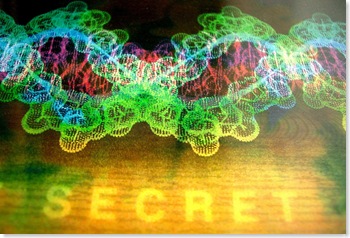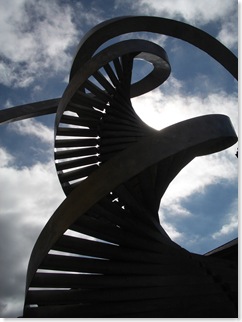Public Relations – The art of getting the media to give you free coverage.
In our Part 1 Cracking the PR Code podcast, Gary Vaynerchuk of Wine Library TV advised us to embrace our personal DNA and understand authenticity. Within Gary’s advice lies the key to cracking the PR code. There is a DNA to publicity. That DNA contains the blueprint to getting great PR. It’s not a secret, and it’s not complicated, but it must be followed.
 |
| Credit: Flickr photo by jurvetson |
THE PR CODE
| Get Noticed | Be Notable | Make it Noteworthy |
Get Noticed
Gary Vaynerchuk of Wine Library TV has been featured on Nightline and has appeared on Late Night with Conan. How did he do it? He first got noticed. Paul Hansen of Flying Vikings received feature articles in the Killeen Daily Herald and Temple Daily Telegram. How did he do it? He first got noticed.
Vaynerchuk did it on a national level with new media and a wildly successful internet TV show. Hansen did it locally the old-fashioned way: with door-knocking and shoe leather. Hansen doesn’t even have a website for his Flying Vikings program. While they went about it in different ways, both Vaynerchuk and Hansen got noticed.
Rule #1: Put Yourself on the Map
In Guerilla Publicity, Jay Conrad Levinson tells us that you have to “honk your own horn.” “If you don’t tell the world how great you are, no one else will.” He’s right. It takes initiative to get noticed.
Just because you are doing something noticeable, doesn’t mean the press will see it. Don’t expect others to tell your story, you have to do it. On a local level that starts with a news release (formerly known as the press release). It’s not the only way to get noticed, but it is the best and easiest way. Putting a news release on the desk (or inbox) of your target media gets you on the radar screen.
First, think in headlines. Pretend your story is appearing on the front page of the local newspaper. What is the headline that will get the story noticed?
Second, send the news release individually to each reporter/editor/blogger on your target list.
Third, follow up with a phone call/email to each individual that receives your release. Ask them if they received the release. Ask if your story is something they might cover.
CAUTION: Don’t use news releases to sell something, instead, sell a story. Which leads us to cracking the second part of our code.
Free Online Resources:
Free News Release Generation Tool
List of Free Online News Release Distribution Sites
The Local Media PR Formula
 |
| Credit: Flickr photo by nate seiner |
Be Notable
The internet is infested with bad news releases. Because press release distribution sites are free most of the releases are poorly and selfishly written. To get free publicity your story must be notable, or worthy of notice. Does your story merit coverage?
Rule #2: Say Something the Public Wants To Hear
People don’t want to hear that you expanded your sales team or that you are now open later hours. The media doesn’t want to hear about your weekend sale.
However, if you win a major award, or if you have found an innovative use for french fry grease, the public wants to hear about it.
Steven Van Yoder, in his personal PR book, Get Slightly Famous, says you should start by answering the simple question: “What makes this news?” Van Yoder gives us a checklist:
|
|
The public also wants to hear good stories. What do you have to say that’s heart-warming, or gut-wrenching? Van Yoder advises that you “Start by doing a little research, finish by doing a little introspection.”
Use this process:
What stories are currently being told in the media? (research) – What story do you have to tell? (Introspection)
What kind of expertise makes the news? (research) – What is unique about your expertise? (Introspection)
What resources do the media use? (research) – About what subject can you be a resource? (Introspection)
Good publicity feeds on itself. Your first story can be the first step to an every increasing spiral of more visible publicity. The key is cracking the third part of the PR code.
 |
| Credit: Flickr photo by maria keays |
Make it Noteworthy
There’s a country song by Blake Shelton that goes “the more I drink, the more I drink.” The same goes for publicity. The more press you get, the more press you will get. Before being featured on Nightline, Gary Vaynerchuk was featured in New York Magazine. Now he has written a book and hints even bigger things are on the way. Remember, Rachel Ray started by doing cooking segments on local news shows. Now, she hosts her own national show. Vaynerchuck’s and Ray’s stories had legs to go the distance.
Being noteworthy means that people will sit up and take notice. You have a story that makes people say, “Hey, I need to remember that.” It also means that other, larger media will notice you.
Rule #3: Go the Distance, Go For Viral
David Meerman Scott, in The New Rules of Marketing & PR says that “there are times an organization possesses news that is so important to the target market they serve, that they just know the news has significant value.” He adds that “with careful nurturing over the news cycle and an awareness of traditional news media’s and bloggers’ roles in promoting ideas, the story can reach much larger audiences and help a smart organization to reach it’s goals.”
And your goal is to be noteworthy enough to get a form viral publicity that leads to more PR in larger venues. Follow this blueprint:
Be Authentic – Don’t try to impersonate someone else. Be original, but be yourself. Scott says “if your mother would say it’s wrong, it probably is.”
Have Broad Appeal – The media (and the blogosphere) want stories that reach a wide variety of people. Have a story with which a lot of people can think, feel and identify.
Be Visual – People love stories they can picture, whether or not they get to see an actual picture or video. Your story can’t be something abstract. Can you use visualizations to illustrate your story and give it life?
Follow up – When you do get some publicity, it’s just the beginning. Don’t let it sit there. In Guerrilla Publicity, Jay Conrad Levinson advises you to “Promote Early, Forcefully, and Fast.” Make copies of your print article, get that video of your local TV appearance, bookmark that link to the blog post. Then send those things to larger media outlets. It’s proof that you are noteworthy.
Crack The Code
Editors, reporters and bloggers are always looking for a good story. Help them out. Because now you know the code. And now you know that the next time someone gets free publicity, it could be you. Embrace your publicity DNA.
PR Resources:
The New Rules of Viral Marketing ebook by David Meerman Scott
Haven’t subscribed to The Marketing Spot yet? Do it now: ![]() Subscribe in a reader
Subscribe in a reader

[…] articles: Cracking The PR Code, Part 2: The DNA of Publicity Guerrilla Marketing Ideas: Building a brand with guerrilla packaging. Viral Gone […]
[…] more information on getting PR for your business, see these articles: Cracking The PR Code: The DNA of Publicity Guerrilla Marketing: Plan Your Give Away Carefully Creating Your Own World Wide […]
[…] articles on World Wide Raves and David Meerman Scott: Tuned In Cracking The PR Code, Part 2: The DNA of Publicity Marketing Basics: […]
[…] This is first of a special, two-part series on getting publicity for your small business. See Part 2: The DNA of Publicity […]